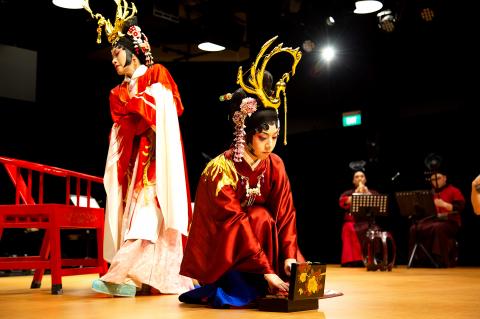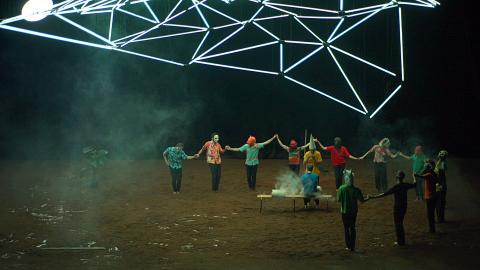PHAEDRA (費特兒), a cross-cultural, cross-genre production of National Guoguang Opera Company (國立國光劇團) and Singapore’s Siong Leng Musical Association (湘靈音樂社), could have been one of those international collaborative efforts that sound better on paper than on the stage.
However, although purists might quibble about some of the details, PHAEDRA proved to be a captivating blend of Beijing opera, nanguan (南管) music, a 17th century French playwright’s retelling of Roman and Greek myths and contemporary Western dance.
The show, which premiered at the Taiwan Traditional Theatre Center’s Experimental Theater on Friday night as part of the Taiwan Traditional Theatre Festival (臺灣戲曲藝術節), is basically a two-woman show; three if you count Chu Sheng-li’s (朱勝麗) doubling in the roles of the queen and her lady-in-waiting.

Photo courtesy of National Guoguang Opera Company
The production had layers upon layers of management behind the scenes. There were two producers, two artistic directors, two music directors and two composers — one from each company. Five performers, not counting the musicians, performed a Chinese, or at least oriental, version of playwright Jean Racine’s tragedy.
Its staging is bare-bones as well, given the hopes of both troupes that it will eventually tour to other nations, with a dramatic black scrim on three sides that encloses the action and hides eight members of the orchestra along the left of the stage.
A strong script by Chao Hsueh-chun (趙雪君), direction by Tai Chun-fang (戴君芳) and choreography by Taipei National University of the Arts professor Zhang Xiao-xiong (張曉雄) kept both the story and the action flowing, but it was really Chu’s performance that makes PHAEDRA such a powerful show.

Photo courtesy of Lin I-chu, National Theater Concert Hall
However, the surprise was 24-year-old Lim Ming Yi (林明依), the lead nanguan vocalist from Singapore, who serves as both the opera’s narrator and, occasionally, the queen’s inner voice. She might be young, but she has a commanding stage presence.
The opera revolves around the actions of the queen, whose husband has been off fighting for months. She has long been anxious to ensure that her son, the crown prince, inherits the throne instead of her husband’s eldest son by a concubine from a tribe that is the long-time rival to her own family. She had sought her stepson’s exile seven years earlier to protect her own son, and had even plotted to have him assassinated, only to relent at the last minute.
As Lim explains in the opening scene, for 365 nights the queen has dreamed of a mystery man, one who physically dominates her, but her dreams always end before she can see his face or touch his lips.
Those fantasy encounters are danced by Wu Chien-wei (吳建緯) as the stepson, with Wu Meng-ting (吳孟庭) as Wu’s alter ego and Li Guan-lin (李冠霖), who doubles as the Queen’s dream figure and the girl she sent to fill her stepson’s bed and keep tabs on him.
When the queen realizes her mystery man is her stepson, she knows she must keep her passions hidden, but when news comes that the king has died in battle, she dares to dream that she can declare her love and it will be reciprocated.
However, the horrified prince recoils, calls her a slut and slashes her neck with his sword. The queen realizes too late is that some fantasies are better left in dreams.
Chu perfectly captures the moment when the queen’s world crumbles. She crumples to the floor, the long sleeves of her robe crossed in front of her throat and over her shoulders. Quivering silently, she looks as if her sleeves are strangling her.
It is a powerful foreshadowing of the fate she will later inflict on her stepson — after he has been blinded on orders of his very much alive father — with a dramatic length of blood red silk.
It was a powerful denouement and beautifully crafted image.
The stage design was by Lin Shih-lun (林仕倫), with lighting by Wang Tien-hung (王天宏), costumes by Keith Lin (林秉豪) and stunning headdresses by Jang Mei-fang (張美芳).
While the English translation provided in the surtitles was rather silted, it allowed non-Mandarin speakers (or readers) to keep up with the action.
The cast heads to Singapore today for two performances at the Stamford Art Centre this weekend.
RIZZO RUNS RIOT
On Saturday night, I saw une maison, the new work by Christian Rizzo, artistic director of ICI-CCN Montpellier, at the National Theater as part of the Taiwan International Festival of Arts.
I thoroughly enjoyed it, but cannot even begin to figure out what Rizzo was trying say — I gave up trying to make sense of it about 20 minutes into the show.
Une maison is a schizophrenic ride, partly because it appears to be two different works. The first half is an almost academic exploration of line, patterns and movements; the second becomes a mad explosion of energy — and dirt — that culminates with the entire cast line dancing in a half circle as smoke rise from various parts of the stage, and one dancer is draped like a ghost.
The piece opens with a solitary male dancer, in a white face mask, executing a series of precise circular steps, knees bent, hands on hips, under a massive lighting sculpture — created by Rizzo — that is either a large insect, or meant to represent the millions of galaxies hovering above the Earth.
The sculpture looms over the action, with one pole almost reaching the floor, which is bare except for a carefully mounded cone of dirt to one side.
The light poles crackle and sizzle before flooding on. Over the course of the show, some of the poles will go dark and then back on, some, it turns out, can be lowered or raised by the dancers by the lines attached to the stanchions that line the two sides of the stage.
The dancers emerge in ones and twos. They connect, pair off and part. There were 13 dancers in all, but they were rarely onstage together.
Most of the dancing comes in solos, pairs, trios or groups of eight or nine, propelled by the driving, percussive beat of the score by frequent Rizzo collaborators Penelope Michel and Nicolas Devos of the electro-pop group Cercueil/Puce Moment.
About three-quarters of the way through, one man starts attacking the dirt cone with a shovel, hurling dirt in broad sweeps across the stage, as other dancers move with equally broad steps and arm movements.
The shovel changes hands, four dancers appear wearing large cones on their heads and wielding long sticks with which they create patterns in the dirt on the floor and move it around.
More dancers appear in white face masks, some don rubber animal heads. They join hands along the back, raise their arms and slowly dance around to the front and then off the stage.
In the program notes, Rizzo talks about Earth being home to humans, but just one tiny bit of the universe, and that homes can be physical entities as well as constructs of our presence and our memories.
I didn’t get the connection between that image and what he produced on stage, but in the galaxy that is Rizzo’s dance world, I didn’t care. I just enjoyed the dance.

The canonical shot of an East Asian city is a night skyline studded with towering apartment and office buildings, bright with neon and plastic signage, a landscape of energy and modernity. Another classic image is the same city seen from above, in which identical apartment towers march across the city, spilling out over nearby geography, like stylized soldiers colonizing new territory in a board game. Densely populated dynamic conurbations of money, technological innovation and convenience, it is hard to see the cities of East Asia as what they truly are: necropolises. Why is this? The East Asian development model, with

June 16 to June 22 The following flyer appeared on the streets of Hsinchu on June 12, 1895: “Taipei has already fallen to the Japanese barbarians, who have brought great misery to our land and people. We heard that the Japanese occupiers will tax our gardens, our houses, our bodies, and even our chickens, dogs, cows and pigs. They wear their hair wild, carve their teeth, tattoo their foreheads, wear strange clothes and speak a strange language. How can we be ruled by such people?” Posted by civilian militia leader Wu Tang-hsing (吳湯興), it was a call to arms to retake

This is a deeply unsettling period in Taiwan. Uncertainties are everywhere while everyone waits for a small army of other shoes to drop on nearly every front. During challenging times, interesting political changes can happen, yet all three major political parties are beset with scandals, strife and self-inflicted wounds. As the ruling party, the Democratic Progressive Party (DPP) is held accountable for not only the challenges to the party, but also the nation. Taiwan is geopolitically and economically under threat. Domestically, the administration is under siege by the opposition-controlled legislature and growing discontent with what opponents characterize as arrogant, autocratic

When Lisa, 20, laces into her ultra-high heels for her shift at a strip club in Ukraine’s Kharkiv, she knows that aside from dancing, she will have to comfort traumatized soldiers. Since Russia’s 2022 invasion, exhausted troops are the main clientele of the Flash Dancers club in the center of the northeastern city, just 20 kilometers from Russian forces. For some customers, it provides an “escape” from the war, said Valerya Zavatska — a 25-year-old law graduate who runs the club with her mother, an ex-dancer. But many are not there just for the show. They “want to talk about what hurts,” she